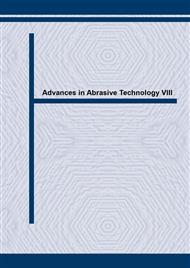p.97
p.103
p.109
p.115
p.121
p.127
p.133
p.139
p.145
ELID Grinding Properties of High-Strength Reaction-Sintered SiC
Abstract:
The high-strength reaction-sintered silicon carbide (RS-SiC) developed by TOSHIBA is one of the most excellent materials for large-scale space-borne optics. The bending strength of the high-strength RS-SiC is two times higher than other SiC ceramics. The purpose of this study is to investigate the ELID grinding properties of the high strength RS-SiC. Two types of metal bond diamond wheels (cup type and straight type) were used to grinding tests. The ground surface properties, such as roughness, subsurface damage and micro-step were made clear by measurement or observation. It was confirmed that, both the surface roughness and the depth of micro-step produced by cup-wheel were lower than those produced by straight-wheel. When a #20000 grit sized cup-wheel was used, a considerably high quality mirror surface (Ra<0.8nm) can be achived.
Info:
Periodical:
Pages:
121-126
Citation:
Online since:
August 2005
Authors:
Price:
Сopyright:
© 2005 Trans Tech Publications Ltd. All Rights Reserved
Share:
Citation:


